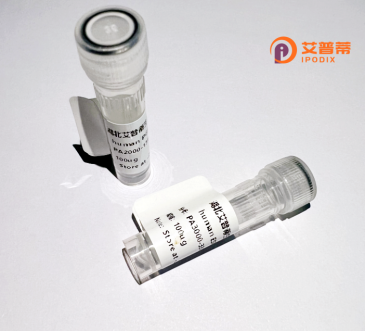
| 纯度 | >90%SDS-PAGE. |
| 种属 | Human |
| 靶点 | USP9X |
| Uniprot No | Q93008 |
| 内毒素 | < 0.01EU/μg |
| 表达宿主 | E.coli |
| 表达区间 | 1-90 aa |
| 活性数据 | MTATTRGSPVGGNDNQGQAPDGQSQPPLQQNQTSSPDSSNENSPATPPDEQGQGDAPPQLEDEEPAFPHTDLAKLDDMINRPRWVVPVLP |
| 分子量 | 35.64 kDa |
| 蛋白标签 | GST-tag at N-terminal |
| 缓冲液 | PBS, pH7.4, containing 0.01% SKL, 1mM DTT, 5% Trehalose and Proclin300. |
| 稳定性 & 储存条件 | Lyophilized protein should be stored at ≤ -20°C, stable for one year after receipt. Reconstituted protein solution can be stored at 2-8°C for 2-7 days. Aliquots of reconstituted samples are stable at ≤ -20°C for 3 months. |
| 复溶 | Always centrifuge tubes before opening.Do not mix by vortex or pipetting. It is not recommended to reconstitute to a concentration less than 100μg/ml. Dissolve the lyophilized protein in distilled water. Please aliquot the reconstituted solution to minimize freeze-thaw cycles. |
以下是关于重组人USP9X蛋白的3篇典型参考文献的简要归纳:
---
1. **文献名称**:*"USP9X deubiquitinates ALK to regulate ALK kinase activity and target expression"*
**作者**:Tania M. Baker 等
**摘要**:研究揭示USP9X通过去泛素化调控ALK激酶的活性,维持其在肺癌等癌症中的蛋白稳定性,为靶向治疗提供依据。
2. **文献名称**:*"Structural basis of ubiquitin recognition by USP9X"*
**作者**:David Komander 团队
**摘要**:解析了USP9X催化结构域与泛素的复合体晶体结构,阐明其底物识别和去泛素化酶活性的分子机制。
3. **文献名称**:*"USP9X regulates Wnt/β-catenin signaling by deubiquitinating β-catenin in colorectal cancer"*
**作者**:Jianhua Wang 等
**摘要**:发现USP9X通过去除β-catenin的泛素化修饰促进其稳定,激活Wnt通路驱动结直肠癌进展。
---
**备注**:建议通过PubMed或Google Scholar输入关键词“recombinant USP9X protein”或“USP9X structural/functional study”获取更详细的最新文献。关注领域内权威期刊如*Nature Cell Biology*、*Cell Reports*及*PNAS*的相关论文。
USP9X (Ubiquitin-Specific Protease 9X), encoded by the USP9X gene located on the X chromosome, is a deubiquitinating enzyme (DUB) belonging to the ubiquitin-specific protease family. It plays a critical role in regulating protein stability and function by removing ubiquitin chains from target substrates, thereby modulating diverse cellular processes such as apoptosis, cell adhesion, migration, and signal transduction. USP9X is involved in key pathways, including the Wnt/β-catenin and TGF-β signaling cascades, and interacts with substrates like AF-6. β-catenin, and SMURF1 to influence developmental, neurological, and oncogenic processes.
Recombinant human USP9X protein is engineered through heterologous expression systems (e.g., bacteria, mammalian cells) to study its enzymatic activity, structural dynamics, and interactions. It serves as a vital tool for investigating USP9X's role in diseases, particularly cancers (e.g., glioblastoma, leukemia) and neurodegenerative disorders, where dysregulation of ubiquitination is implicated. Its recombinant form enables high-purity studies on substrate specificity, inhibitor screening for therapeutic development, and mechanistic insights into deubiquitination. Research on recombinant USP9X also explores its dual roles as either an oncogene or tumor suppressor, depending on cellular context, highlighting its therapeutic potential as a drug target.
×